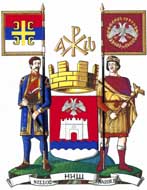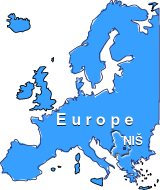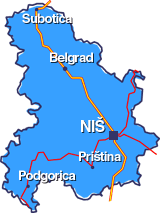About Our City
History The Region of Niš


Niš occupies the crossroads of the most important Balkan and European traffic lines. These roads have been widely known from ancient times, because they represented the beaten tracks along which peoples, goods and armies moved. Known as 'Via Militaris' in Roman and Byzantine periods, or 'Constantinople road' in Middle Ages and the period of Turkish rule, these roads still represent major European traffic arteries. Niš thus stands at a point of intersection of the roads connecting Asia Minor to Europe, and the Black Sea to the Mediterranean. The city of Niš is natural, social, economic, educational, health and sport centre of the southeast Serbia, with the population of over 250 000 inhabitants. The total area covered by the city is 597 square kilometres.
History
According to a legend, Niš was founded by a Prince Naissa, who built it. There is abundant archaeological evidence that Niš was inhabited in prehistoric times. The town was named after the Nišava River, which was named Navissos by the Celtic inhabitants of the town. In ancient times, Naissus was an important stronghold and an invincible castrum. Its extraordinary geographic position made Naissus an important strategic spot, mentioned in many records on military affairs in the Balkans. Roman Emperor Constantine the Great was born in Niš in 274. During his reign (306-337), Constantine built majestic edifices here (Mediana), and made Niš an important economic, military and administrative centre.
Niš was besieged, raided, sacked, ravaged and burned to the ground several times in its long and turbulent history. The gates of Niš saw in several well-known dignitaries of Europe. In 1189 Niš welcomed Emperor Frederick I Barbarossa. In the period of Turkish rule, Niš was one of the seats of Turkish military and civil administration. Niš Fortress, built in that period, still represents one of the most beautiful and best preserved Turkish edifices in the Balkans.
During the First Serbian Uprising, on May 31st 1809, the Battle of Čegar took place, in which the duke Stevan Sindjelić was killed together with 3000 Serbian soldiers. After the battle on Čegar Hill, upon the order of Turkish pasha, the skulls of the killed Serbian soldiers were built in a tower - Skull Tower, a unique monument in the world.
On January 11th 1878 Prince Milan Obrenović liberated the city and it became the alternative capital of Serbia. During World War I, Niš was proclaimed the war capital of Serbia. After the occupation in Worl War II, on October 14th 1944, Niš was liberated from the Germans.
The Region of Niš
Several kilometres from Niš there is Niška Banja (spa of Niš), which is the natural spa and was well known from the Rome empire. Its medical abilities and specification came from the radon termomineral water from the spring. It is placed on the hight of 250 metres and the climate is miled continental.
There are two canyones near Niš: Jelašnička and Sićevačka.



